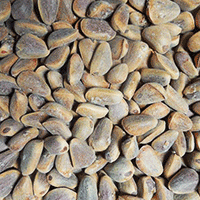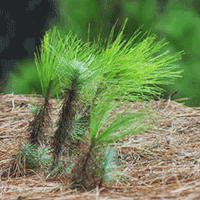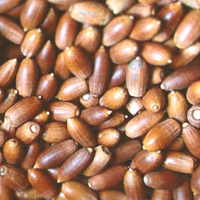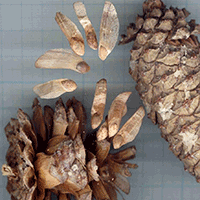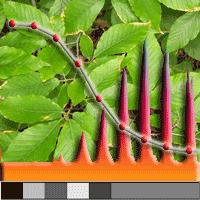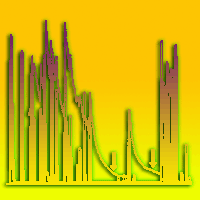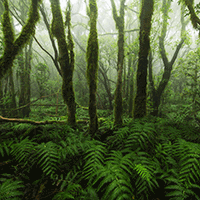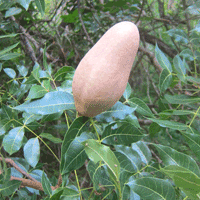Light transmittance regulated by canopy openness influences the microsite conditions for natural regeneration. The successful transition from seed germination to subsequent seedling recruitment (i.e., early seedling survival and growth) determines the natural regeneration potential. However, there is little information on the effect of varying light transmittance on seed germination and seedling recruitment of Pinus koraiensis Siebold & Zucc. (Korean pine). We aimed to determine the optimum light requirements for this transition process in P. koraiensis to propose practical measures for improving its natural regeneration. The transition process was studied under five light transmittance regimes (100%, 60%, 30%, 15% and 5% of full light) over two consecutive years (2010 and 2011). The highest germination percentage in both years occurred at 30% light transmittance. Generally, mean germination time (MGT) declined with increased light transmittance. Seedling survival exhibited no significant differences between treatments for 1-year-old seedlings, but was higher at 30% than at 5% light transmittance for the 2-year-old seedlings. In contrast, seedling height, root collar diameter and total biomass were highest at 60%-100% light transmittance for both 1- and 2-year-old seedlings. Furthermore, the light transmittance also influenced the growth characteristics of P. koraiensis seedlings through regulating MGT. These results suggest that growth of P. koraiensis seedling requires a higher light transmittance (60%-100%) than that required for seed germination, even though 30% light transmittance was favorable to the earlier emergence with larger specific leaf area. Silvicultural measures such as thinning are recommended to increase light irradiance in the forest understorey with the aim of improving the natural regeneration of P. koraiensis.
Keywords
, , , ,
Citation
Zhang M, Yan Q, Zhu J (2015). Optimum light transmittance for seed germination and early seedling recruitment of Pinus koraiensis: implications for natural regeneration. iForest 8: 853-859. - doi: 10.3832/ifor1397-008
Academic Editor
Gianfranco Minotta
Paper history
Received: Jul 10, 2014
Accepted: Feb 11, 2015
First online: May 22, 2015
Publication Date: Dec 01, 2015
Publication Time: 3.33 months
© SISEF - The Italian Society of Silviculture and Forest Ecology 2015
Open Access
This article is distributed under the terms of the Creative Commons Attribution-Non Commercial 4.0 International (https://creativecommons.org/licenses/by-nc/4.0/), which permits unrestricted use, distribution, and reproduction in any medium, provided you give appropriate credit to the original author(s) and the source, provide a link to the Creative Commons license, and indicate if changes were made.

Breakdown by View Type
(Waiting for server response...)
Article Usage
Total Article Views: 55036
(from publication date up to now)
Breakdown by View Type
HTML Page Views: 46096
Abstract Page Views: 3175
PDF Downloads: 4252
Citation/Reference Downloads: 33
XML Downloads: 1480
Web Metrics
Days since publication: 3857
Overall contacts: 55036
Avg. contacts per week: 99.88
Article Citations
Article citations are based on data periodically collected from the Clarivate Web of Science web site
(last update: Mar 2025)
Total number of cites (since 2015): 13
Average cites per year: 1.18
Publication Metrics
by Dimensions ©
Articles citing this article
List of the papers citing this article based on CrossRef Cited-by.
(1)
Beaudet M, Messier C (2002)Variation in canopy openness and light transmission following selection cutting in Northern hardwood stands: an assessment based on hemispherical photographs. Agricultural and Forest Meterology 110: 217-228.
CrossRef |
Gscholar
(2)
Chianucci F, Cutini A (2012)Digital hemispherical photography for estimating forest canopy properties: current controversies and opportunities. iForest 5: 290-295.
CrossRef |
Gscholar
(3)
Close DC, Wilson SJ (2002)Provenance effects on pre-germination treatments for
Eucalyptus regnans and
E. delegatensis seed. Forest Ecology and Management 170: 299-305.
CrossRef |
Gscholar
(4)
Day ME, Schedlbauer JL, Livingston WH, Greenwood MS, White AS, Brissette JC (2005)Influence of seedbed, light environment, and elevated night temperature on growth and carbon allocation in pitch pine (
Pinus rigida) and jack pine (
Pinus banksiana) seedlings. Forest Ecology and Management 205: 59-71.
CrossRef |
Gscholar
(5)
Demir I, Ermis S, Mavi K, Matthews S (2008)Mean germination time of pepper seed lots (
Capsicum annuum L.) predicts size and uniformity of seedlings in germination tests and transplant modules. Seed Science and Technology 36: 21-30.
CrossRef |
Gscholar
(6)
Fady B, Fineschi S, Vendramin GG (2004)EUFORGEN Technical guidelines for genetic conservation and use for Italian stone pine (
Pinus pinea). International Plant Genetic Resources Institute, Rome, Italy, pp. 6.
Online |
Gscholar
(7)
Figueroa JA, Lusk CH (2001)Germination requirements and seedling shade tolerance are not correlated in a Chilean temperate rain forest. New Phytologist 152: 483-489.
CrossRef |
Gscholar
(8)
Ganatsas PP, Tsakaldimi MN (2007)Effect of light conditions and salinity on germination behaviour and early growth of umbrella pine (
Pinus pinea L.) seed. Journal of Horticultural Science and Biotechnology 82 (4): 605-610.
Online |
Gscholar
(9)
Guo LP, Ji LZ, Zhang WD, Zhang Y, Xue JG (2010)Forest recovery state in wind disaster area of Changbai Mountains, Northeast China. Chinese Journal of Applied Ecology 21 (6): 1381-1388. [in Chinese with English abstract]
Gscholar
(10)
Hussain M, Kubiske ME, Connor KF (2001)Germination of CO
2-enriched
Pinus taeda L. seeds and subsequent seedling growth responses to CO
2 enrichment. Functional Ecology 15: 344-350.
CrossRef |
Gscholar
(11)
Kyereh B, Swaine MD, Thompson J (1999)Effect of light on the germination of forest trees in Ghana. Journal of Ecology 87 (5): 772-783.
CrossRef |
Gscholar
(12)
Ma JL, Zhuang LW, Chen D, Li JW (1992)The geographic distribution of
Pinus koraiensis. Journal of Northeast Forestry University 20 (5): 40-48. [in Chinese]
Gscholar
(13)
McLaren KP, McDonald MA (2003)The effects of moisture and shade on seed germination and seedling survival in a tropical dry forest in Jamaica. Forest Ecology and Management 183: 61-75.
CrossRef |
Gscholar
(14)
Moya D, De Las Heras, Salvatore R, Valero E, Leone V (2013)Fire intensity and serotiny: response of germination and enzymatic activity in seeds of
Pinus halepensis Mill. from southern Italy. Annals of Forest Science 70: 49-59.
CrossRef |
Gscholar
(15)
Nocentini S (2009)Structure and management of beech (
Fagus sylvatica L.) forests in Italy. iForest 2: 105-113.
CrossRef |
Gscholar
(16)
Noe GB, Zedler JB (2001)Spatio-temporal variation of salt marsh seedling establishment in relation to the abiotic and biotic environment. Journal of Vegetation Science 12 (1): 61-74.
CrossRef |
Gscholar
(17)
Parker WC, Noland TL, Morneault EA (2004)Effect of seed mass on early seedling growth of five eastern white pine (
Pinus strobus L.) families under contrasting light environments. Canadian Journal of Botany 82 (1): 1645-1655.
CrossRef |
Gscholar
(18)
Parker WC, Noland TL, Morneault EA (2006)The effects of seed mass on germination, seedling emergence, and early seedling growth of eastern white pine (
Pinus strobus L.). New forests 32: 33-49.
CrossRef |
Gscholar
(19)
Pons TL (1992)Seed responses to light. In: “Seeds-the ecology of regeneration in plant communities” (Fenner M ed). CAB international, Wallingford, UK, pp. 259-284.
Online |
Gscholar
(20)
Poorter L, Kitajima K (2007)Carbohydrate storage and light requirements of tropical moist and dry forest tree species. Ecology 88 (4): 1000-1011.
CrossRef |
Gscholar
(21)
Pothier D, Prévost M (2002)Photosynthetic light response and growth analysis of competitive regeneration after partial cutting in a boreal mixed stand. Trees 16: 365-373.
Online |
Gscholar
(22)
Pulinets MP (1986)The influence of light intensity on the growth of
Pinus koraiensis. Lesnoe Khozyaistvo 4: 40-42.
Gscholar
(23)
Ren H, Lu HF, Wang J, Liu N, Guo QF (2012)Forest restoration in China: advances, obstacles, and perspectives. Tree and Forestry Science and Biotechnology 6: 7-16.
Online |
Gscholar
(24)
Ren J, Tao L (2004)Effects of different pre-sowing seed treatments on germination of 10
Calligonum species. Forest Ecology and Management 195: 291-300.
CrossRef |
Gscholar
(25)
Rich P, Clark DB, Clark DA, Oberbauer SF (1993)Long-term study of solar radiation regimes in a tropical wet forest using quantum sensors and hemispherical photography. Agricultural and Forest Meteorology 65: 107-127.
CrossRef |
Gscholar
(26)
Ruano I, Pando V, Bravo F (2009)How do light and water influence
Pinus pinaster Ait. germination and early seedling development? Forest Ecology and Management 258: 2647-2653.
CrossRef |
Gscholar
(27)
Seiwa K, Ando M, Imaji A, Tomita M, Kanou K (2009)Spatio-temporal variation of environmental signals inducing seed germination in temperate conifer plantations and natural hardwood forests in northern Japan. Forest Ecology and Management 257: 361-369.
CrossRef |
Gscholar
(28)
Silvertown JW, Doust L (1993)Introduction to plant population biology. Blackwell, London, UK, pp. 122-152.
Gscholar
(29)
South DB, Larsen HS, Williams HM, Boyer JN (1989)Use of seedling size as a covariate for root growth potential studies. In: Proceedings of the “5th Biennial Southern Silvicultural Research Conference” (Miller J ed). New Orleans (LA, USA), 1-3 Nov 1988. Memphis, TN, USA, pp. 89-93.
Online |
Gscholar
(30)
Tanaka-Oda A, Tanaka K, Fukuda K (2009)Optimal germination condition by sulfuric acid pretreatment to improve seed germination of
Sabina vulgaris Ant. Journal of Forest Research 14: 251-256.
CrossRef |
Gscholar
(31)
Wu XP, Zhu B, Zhao SQ, Piao SL, Fang JY (2004)Comparison of community structure and species diversity of mixed forests of deciduous broad-leaved tree and Korean pine in Northeast China. Biodiversity Science 12 (1): 174-181. [in Chinese with English abstract]
Online |
Gscholar
(32)
Xiong SJ, Nilsson C (1999)The effects of plant litter on vegetation: a meta-analysis. Journal of Ecology 89: 984-994.
CrossRef |
Gscholar
(33)
Yang K, Zhu JJ, Shi W (2013)The impact of secondary forests conversion into larch plantations on soil chemical and microbiological properties. Plant and Soil 368 (1-2): 535-546.
CrossRef |
Gscholar
(34)
Zhang M, Zhu JJ, Yan QL (2012)Seed germination of
Pinus koraiensis in response to light regimes caused by shading and seed positions. Forest Systems 21: 426-438.
CrossRef |
Gscholar
(35)
Zhang M, Zhu JJ, Li MC, Zhang GQ, Yan QL (2013)Different light acclimation strategies of two coexisting tree species seedlings in a temperate secondary forest along five natural light levels. Forest Ecology and Management 306: 234-242.
CrossRef |
Gscholar
(36)
Zhu JJ (2002)A review on fundamental studies of secondary forest management. Chinese Journal of Applied Ecology 13 (12): 1689-1694. [in Chinese with English abstract]
Gscholar
(37)
Zhu JJ, Matsuzaki T, Li FQ, Gonda Y (2003)Effect of gap size created by thinning on seedling emergency, survival and establishment in a coastal pine forest. Forest Ecology and Management 182 (1-3): 339-354.
CrossRef |
Gscholar
(38)
Zhu JJ, Liu ZG, Wang HX, Yan QL, Fang HX, Hu LL, Yu LL (2008)Effects of site preparation on emergence and early establishment of
Larix olgensis in montane regions of northeastern China. New Forests 36 (3): 247-260.
CrossRef |
Gscholar
(39)
Zhu JJ, Wang K, Sun YR, Yan QL (2014)Response of
Pinus koraiensis seedling growth to different light conditions based on the assessment of photosynthesis in current and one-year-old needles. Journal of Forestry Research 25 (1): 53-62.
CrossRef |
Gscholar
(40)
Zuur AF, Ieno EN, Elphick CS (2010)A protocol for data exploration to avoid common statistical problems. Methods in Ecology and Evolution 1: 3-14.
CrossRef |
Gscholar
